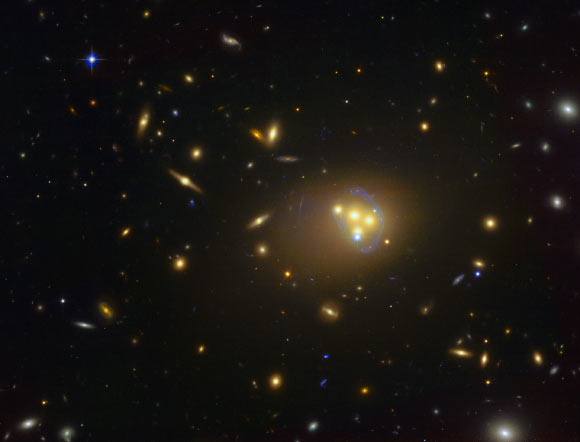Using the NASA/ESA Hubble Space Telescope and the MUSE instrument on ESO’s VLT in Chile, an international group of scientists led by Dr Richard Massey of the Durham University’s Institute for Computational Cosmology, UK, studied the simultaneous collision of four galaxies at the center of the galaxy cluster Abell 3827, and found that one dark matter clump appeared to be lagging behind the galaxy it surrounds.

This image shows Abell 3827, a massive galaxy cluster approximately 1.3 billion light years away. The blue structures surrounding the central galaxies are gravitationally lensed views of a much more distant galaxy behind the cluster. Observations of the central four merging galaxies have provided hints that the dark matter around one of the galaxies is not moving with the galaxy itself, possibly implying dark matter-dark matter interactions of an unknown nature are occurring. Image credit: ESO.
Dr Massey and his colleagues found that each of the Abell 3827’s central galaxies retains a dark matter halo, but that at least one of these is spatially offset from its stars, approximately 5,000 light-years behind the galaxy. Such an offset is predicted during collisions if dark matter interacts, even very slightly, with forces other than gravity.
Although dark matter cannot be seen, the scientists could deduce its location using gravitational lensing. The mass of dark matter around the galaxies in Abell 3827 severely distorted spacetime, deviating the path of light rays coming from the distant background galaxy – and distorting its image into characteristic arc shapes.
“We used to think that dark matter just sits around, minding its own business, except for its gravitational pull. But if dark matter were being slowed down during this collision, it could be the first evidence for rich physics in the dark sector – the hidden Universe all around us,” said Dr Massey, who is the lead author of the paper published in the journal Monthly Notices of the Royal Astronomical Society (arXiv.org preprint).
“Dark matter may not be completely ‘dark’ after all,” he said.
The astronomers said that while they appear to have observed the offsetting of dark matter, more investigation will be needed into other potential effects that could also produce a lag between the dark matter and the galaxy it hosts. Similar observations of more galaxies and computer simulations of galaxy collisions are under way to confirm the interpretation.
Co-author Dr Liliya Williams of the University of Minnesota added: “we know that dark matter exists because of the way that it interacts gravitationally, helping to shape the Universe, but we still know embarrassingly little about what dark matter actually is.”
“Our observation suggests that dark matter might interact with forces other than gravity, meaning we could rule out some key theories about what dark matter might be.”
_____
Richard Massey et al. 2015. The behaviour of dark matter associated with four bright cluster galaxies in the 10 kpc core of Abell 3827. MNRAS 449 (4): 3393-3406; doi: 10.1093/mnras/stv467







